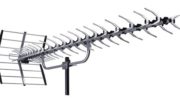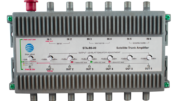You hear that term a lot, whether it’s a computer, radio, TV, or satellite installation. It seems like it’s a good way of measuring things, but did you ever stop to think about the term and what it means?
First, you have to know what a hertz is
The hertz is a unit of measurement named after pioneer electricity theorist Heinrich Hertz, and it describes a complete cycle per second. If you can walk around in a circle fast enough that you make it around once every second, you’re walking at one hertz. If you can jump up and down once a second, you’re jumping at one hertz. Do you want to know a lot more about Hertzes (and hertzes)? read this article.
The metric system actually is good for something
If you apply the normal metric system prefixes to “hertz” you get measurements that are usually used for something having to do with electricity. By their very nature, electromagnetic fields pulse in and out (or back and forth depending on your point of view.) They tend to do this fairly quickly. Regular electricity coming through your wall outlet pulses at 60 hertz, but radio transmissions start at 540 kilohertz (540,000 times per second) and go up from there. Most TV reception is in the 250-600 megahertz (250,000,000 pulses per second) while satellte transmission is in the gigahertz range. The greater the frequency, the longer a signal can travel but it requires more power to make it do so.
Megahertz: not just for broadcasts anymore
It’s worth mentioning that megahertz and gigahertz are also used to measure the speed of computer processors, and in this case the term refers to a complete instruction performed by a processing unit. Even though most things in computers are expressed in powers of two (for example a megabyte isn’t 1,000,000 bytes, it’s 1,024,578 bytes) megahertz aren’t like that, and can be any number needed.
It’s a useful term and it leads you to an understanding of the “electromagnetic spectrum” two very important words. They describe how radio waves of all frequencies can exist all around us. Not only that, different waves on the electromagnetic spectrum don’t interfere with each other in general. Some radio waves are visible to us. We call those waves “light.” Some do such a poor job of passing through organic matter that they actually heat it up. We call those waves “microwaves.” We use special devices to mess with the waves in such a way that they carry information that can be decoded later. This sort of radiation is used for radio, TV and satellite. At the end of the day it’s all electromagnetic radiation. The big difference between the types of waves… is measured in megahertz.
But can hertz… hurt?
Forgive the wordplay, friends, but it’s something that’s worth mentioning. There are some folks who claim that cellular radiation, or TV antenna broadcasts, can be harmful to you. I’m not a doctor. I’m a blogger. I’ll say that for sure, anything can harm you if you have enough of it. But it doesn’t seem like the amounts of broadcast radiation you’re exposed to are likely to hurt you. It seems, at least not at the frequencies it occurs. These signals are fractions of a watt and that makes them less powerful than night lights. Because they’re also lower frequencies than night lights, they’re a lot less likely to harm living cells. But as i said, don’t just take my word for it. Seek out the experts and you’ll find the same explanations.
Oh, and if you’re looking for any broadcast or reception equipment, shop the great selection at Solid Signal.





